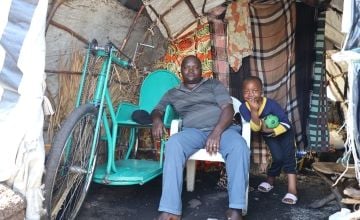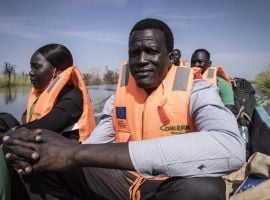
Knowledge Hub
The DRC: Where the humanitarian situation is worsening by the day
Alarm bells are ringing as a deadly mix of violence, natural disasters, pervasive poverty and lack of basic services conflates in the Democratic Republic of the Congo, putting millions of lives at risk.
Humanitarian response in eastern Democratic Republic of Congo (DRC) has rapidly ramped up following months of relentless violence and growing humanitarian needs. Increasing violence, combined with extensive poverty, natural disasters, and lack of services, is causing the levels of hunger and malnutrition, displacement and protection risks, such as gender based violence, in the eastern provinces of the DRC to rise dramatically.

Extraordinary levels of displacement
Since the start of the year, more than 2,750 innocent people have been killed in the region. Many rural communities have had no choice but to abandon their fields for fear of attacks. As a result, over the last year, food production has fallen by 25% in certain areas of the country.
Since March 2022, 2.8 million people have been forced to flee their homes in the provinces of North Kivu, South Kivu and Ituri. 330,000 people were displaced in March 2023 alone. The DRC now has 6.3 million internally displaced people, the highest number of any African country.
The country is the fourth largest in Africa, and yet people are being forced to live in cramped and dirty makeshift sites or camps. Moreover, outbreaks of Ebola, measles, cholera and other diseases are worsening the humanitarian crisis.
Huge levels of food insecurity
Approximately 6.7 million people (34 percent of the population) are in crisis and emergency levels of food insecurity in these eastern provinces. This is a 10 percent rise in food insecurity since the conflict escalated.
Recent forecasts indicate that 25.8 million people in the DRC will face acute food insecurity in 2023 – the highest number worldwide. A person is food insecure ‘when they lack regular access to enough safe and nutritious food for normal growth and development and an active and healthy life.’ [FAO]
Where access to food is available, in North Kivu alone, the price of staples such as flour and beans has increased by over 30% in the space of a year.
Women and children particularly at risk
In the first three months of 2023, over 31,000 cases of gender-based violence were recorded. The real number is likely much higher, as sexual violence often goes unreported.
Violations against children are also on the rise, with increasing levels of child recruitment, abductions, murder, mutilation and sexual violence.

What are we doing to help?
Concern has been working in the DRC since 1994.
In 2022, we supported over 150,000 individuals displaced by conflict and natural disasters with emergency cash transfers/vouchers and food distributions, funded by the UK government and BHA. Last year our gender and protection teams also carried out gender transformative trainings and sensitisations in local communities, reaching 3,866 women and 2,714 men, while our school workshops to raise awareness from an early age about equality reached 1,215 children.
Over 350,000 individuals living in rural communities and IDP sites in Eastern DRC were reached with WASH interventions, including the provision of access to clean drinking water and improved sanitation through the trucking of emergency water supplies, the rehabilitation and construction of water points, toilets and showers and community hygiene promotion activities carried out by Concern’s expert water, sanitation and hygiene teams.
What else needs to be done?
Despite the escalation of the humanitarian crisis, the response is drastically underfunded at just 28 percent. Much more is needed to support people affected. Moreover, the solutions to this neglected crisis go beyond our work. The international community must step up its political and diplomatic commitment to securing a resolution and putting an end to this perpetual cycle of violence and humanitarian crisis in the DRC.
Other ways to help
Donate now
Give a one-off, or a monthly, donation today.
Join an event
From mountain trekking to marathon running, join us for one of our many exciting outdoor events!
Buy a gift
With an extensive range of alternative gifts, we have something to suit everybody.
Leave a gift in your will
Leave the world a better place with a life-changing legacy.
Become a corporate supporter
We partner with a range of organisations that share our passion and the results have been fantastic.
Create your own fundraising event
Raise money for Concern by organising your own charity fundraising event.


